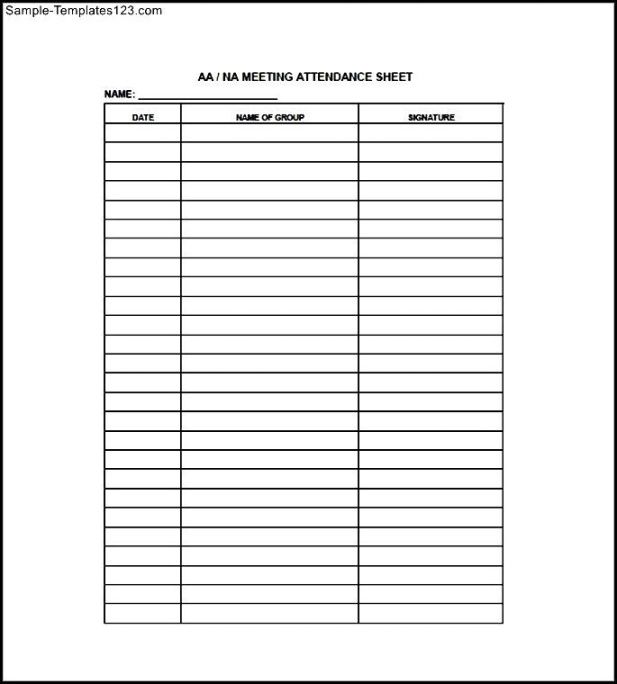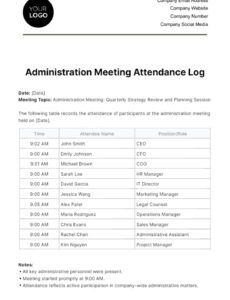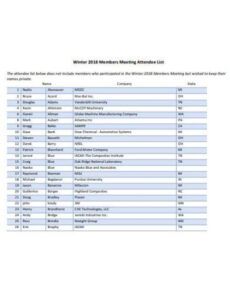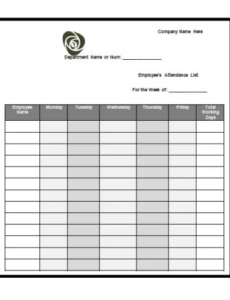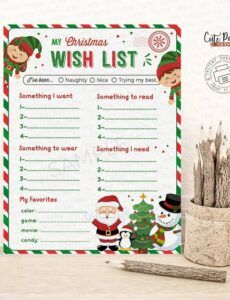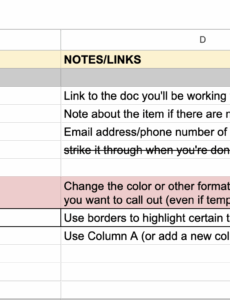Meeting attendance list template. Frustrated with scribbling things on scraps of paper that eventually get lost? Ever caught overlooking crucial responsibilities or items when you’re out and about? Well, many people experience this! It happens to the best of us, trying to balance everything in our heads and having difficulty to stay structured. The best part is a quick fix exists that can restore structure: the classic checklist.
A effective template is not merely lines on a page. It’s a guiding system that leads the way, prompts you, and prevents forgetting important points. It simplifies the process of organizing your content, letting you focus on the actual content. It eliminates wasted minutes, minimizes frustration, and can even boost your productivity. From straightforward task sheets to detailed workflow managers, the perfect format can be a lifesaver.
Whether you’re a student working to handle your assignments, a working expert juggling multiple projects, or just an individual looking for structure to their everyday routine, a pre-designed format can be a major help. It’s a flexible resource that can be customized to work for multiple situations. And the best part? There are tons of options available through digital platforms, just waiting for you to find. So, let’s explore the universe of structured formats and explore how they can organize your life.
Why even consider using a pre-made format when you could just note information on a piece of paper? Well, the truth is, while it can help occasionally, it’s not a sustainable or structured way to maintain order. A Free List Template delivers a variety of benefits that can significantly improve your workflow, reduce stress, and assist in completing your targets.
Firstly, pre-designed formats cut down effort. Consider all the valuable time you use up modifying structure, arranging content, or figuring out the format of your checklist. A template removes all that pre-work, helping you dive immediately into listing your tasks. This is especially beneficial when time is limited or feeling overwhelmed.
Another key feature is better reliability. When you apply a template multiple times, you develop a consistent approach to managing your tasks. This simplifies to track progress, identify possible issues, and analyze trends through various stages. This consistency is especially valuable for collaborative efforts working on collaborative projects, as it guarantees that the whole team follows a unified process and adhering to the same workflow. This, in turn, enhances stronger coordination and teamwork.
The ease of use of pre-designed task sheets has also exploded in recent years, thanks to the internet and the proliferation of productivity platforms. Many widely used work management systems, such as advanced workbooks, Google Sheets, and work planning tools, come with a vast library of pre-built templates covering everything from expense tracking and billing records to event planning and content calendars. Additionally, there are numerous websites and virtual forums focused on exchanging and generating tailored formats, making it simple and fast to locate the ideal option for your requirements.
To conclude, it promotes enhanced judgments. By giving a clear and well-laid-out perspective of the essential details, a structured template can support better thought-out and effective decisions. For example, a budget spreadsheet can help you track your revenue and expenses, helping you recognize cost-cutting opportunities. Similarly, a task organization sheet can help you visualize the schedule and manage time effectively. It is a powerful tool to support your decisions and achieve success.
The universe of pre-designed formats is vast and varied, offering a broad spectrum of choices tailored to specific needs. From simple to-do formats to advanced task coordination tools, there’s a choice out there for virtually any requirement you can consider. Learning about the distinct formats accessible and their functional advantages is key to selecting the most effective template for your organizational structure.
In case you don’t see what you’re looking for within your current programs, try looking on the web for specialized platforms and user groups. Many websites feature cost-free and paid checklist formats created by designers in various fields. Make sure to check the terms of use before installing and using any pre-built checklist, especially if it’s for professional applications. Furthermore, digital communities and communities built for productivity platforms often have sections where users exchange their personalized checklist designs.
[%Next, reflect on the structure of the template. Do you prefer a basic design, or something aesthetic? Would you like a layout that can be optimized for printing, or one that is designed for digital use? Many online resources feature a variety of templates in multiple styles, so you can pick one that fits your preferences. Also, evaluate if you need it on cloud-based document editors, Google Sheets, word processing software, or numerical formats.|Begin by determining what kind of checklist you need to assemble. Are you looking for a straightforward reminder, a detailed project tracker, or a specialized checklist? Once you’ve settled on a precise concept of your needs, you can start searching online. A basic internet lookup like “[%Free List Template for [your specific need]|Pre-made checklist for [your purpose]|Structured format for [your task]%]” will yield a abundance of options.|Once you’ve found a template that appears suitable, don’t hesitate to adapt it to match your specific needs. Most pre-built checklists are built to be flexible, giving you the ability to quickly adjust the headings, divisions, and entries to match your organizational style. Include or exclude sections, adjust the style, and add your personalized touches to build a format that is truly your own. Keep in mind, the objective is to set up a system that helps you succeed, so feel free to test different approaches and modify until it meets all your needs.|Another widely used format is the to-do format. While similar to a structured task sheet, a to-do format typically features enhanced content, such as completion timelines, task importance, and responsible parties. Structured task planners are particularly useful for managing tasks that have fixed timeframes or require collaboration among team members. They can be created using a diverse selection of methods, from traditional notebooks to digital planning systems. The higher level the responsibility, the greater the choice for its organization.%]
When adjusting a checklist, keep in mind the key purposes you’re working towards. Do you want to enhance your efficiency, streamline your workflows, or measure your progress towards a particular goal? Modify the layout to highlight the important data and information that are valuable to your objectives. For example, should you choose a task tracker, ensure it includes areas for recording due dates, delegating tasks, and monitoring progress against the expected deadlines.
Finally, feel free to try out with varied formats until you find one that suits your workflow. There are countless Free List Template available formats and downloads out there, so take some time to browse and sample a few various alternatives. You might be unexpectedly pleased at what you discover.
Utilizing a pre-designed checklist can genuinely change how you organize tasks. It is a solution that can unlock different levels of efficiency and structuring. It will not only enable you to achieve goals but also free up cognitive load so you can concentrate on what is truly important.
It’s about more than just writing things down; it’s centered around introducing a positive change in how you handle your responsibilities and responsibilities. By finding an ideal checklist and tailoring it to your personal workflow, you can convert confusion into structure and achieve your goals with greater ease and efficiency.
